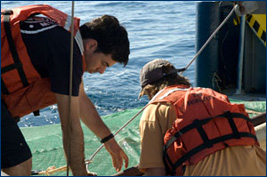
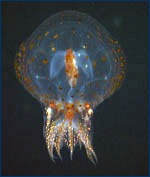
At left, preparing the net for a midwater trawl on the research vessel New Horizon. At right, the octopus Japetella diaphana was one of the recovered animals.
Squid science: Field notes from Stephanie Bush
By UCMP grad student Stephanie Bush, June 4–August 10, 2007
| Stephanie is a graduate student at UCMP currently doing research at the Monterey Bay Aquarium Research Institute (MBARI). She wants to figure out why deep sea squid release ink even though there's very little light in the deep sea. Check out an overview of Stephanie's research, her other updates, or read on to find out what she's been working on recently … |
June 4-12, 2007
 |
 |
||
At left, preparing the net for a midwater trawl on the research vessel New Horizon. At right, the octopus Japetella diaphana was one of the recovered animals. |
|||
There were daily, and sometimes nightly, blue-water SCUBA dives. These dives are performed in open water where divers cannot see the shore or bottom to gauge where they are in the water column. Blue-water divers deploy a rope vertically in the water column, buoyed at the surface and weighted at the lower end, to which each diver is connected by a horizontal tag line. This set-up provides a safety net for the divers, keeping everyone together and preventing them from straying from the dive site. Blue-water dives are key for collecting fragile midwater animals such as jellies, as it is difficult to obtain intact specimens with nets.
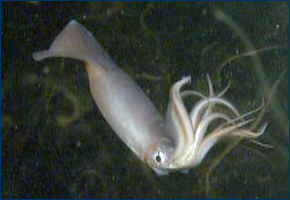 The Humboldt squid Dosidicus gigas. |
July 10, 2007
Back in California, I met with a staff member of the College of Chemistry at the UC Berkeley campus. We discussed how to chemically analyze my squid ink. We prepared to subject my samples to liquid chromatography-mass spectroscopy (LC-MS) in order to compare differences in ink make-up between various deep-sea and shallow squid species.
These are my first squid ink chemical analyses using liquid chromatography-mass spectroscopy and I'm excited and nervous! What if there is nothing interesting there?!
We reserved time for running two preliminary ink samples in the afternoon. The plan was to thaw out the ink samples in the morning here at MBARI, filter them, then put them on ice and drive them up to UC Berkeley, where the analysis would take place.
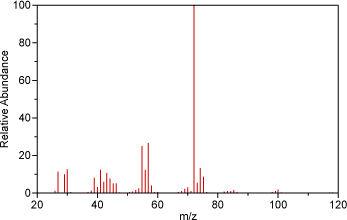 The mass spectrum of valine, an amino acid. Each line on the graph represents a different ion (actually the ratio between the ion's mass and charge). The height of each line represents how common that ion is in the sample. |
We got there just in time to run my samples. The process is complicated, but luckily I had help. Basically, LC-MS involves running ink and a liquid solvent through an incredibly thin tube called a chromatography column. Some of the molecules in the ink will have more affinity for the liquid and will stick with it as it runs through the column; however, other molecules will have more affinity for the specialized material lining the column and will stick inside the column. Having successfully separated out the different kinds of molecules in the ink, we then analyze those molecules with a mass spectrometer. In this second step, the molecules are broken up into ions whose mass and charge are measured and detected. All this data is put together into a mass spectrum for each ink component. That spectrum is something like a fingerprint that we can use to identify the molecule. At right is an example of what one of these fingerprints looks like. As of this writing, I am still performing the laborious analysis of these samples.
August 5-10, 2007
Out to sea again! I spent the week aboard the research vessel Western Flyer studying deep-sea animals in Monterey Bay, CA. My goal was to collect some fresh ink for further chemical analysis. We were lucky to get lovely weather and a relative abundance of squid specimens: Chiroteuthis calyx, Gonatus berryi, a Taonius species, Gonatus onyx, Galiteuthis phyllura, Octopoteuthis deletron, and a Planctoteuthis species.
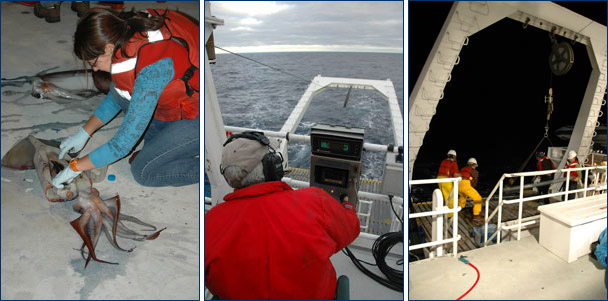 From left, Stephanie collects an ink sample from a squid; trawling for animal specimens; pulling in the net to see what animals have been caught. |
We also performed four midwater net tows. Again, I was hoping to get more squid to increase the amount of ink I have for chemical analyses and behavioral experiments. It was the first time that I was in charge of trawling: determining when the net goes down and comes up, how much line to let out to hit the target depth, coordinating with the ship's captain and the other scientists in order to successfully deploy and retrieve the net. I wanted to target a specific depth range in which I knew squid could be found, but exclude other animals at shallower depths that were not of interest. In order to do this, you send the net to the right depth with the net closed and send a "messenger" down the net's cable to trigger the net to open. Then you trawl around and later send another messenger down to close the net before pulling it up through shallow-water. Unfortunately, when the first messenger is sent down to the net, it often "double trips," causing the net to open and close at the same time — and then one unknowingly tows around a closed net for the allotted time. This happened a few times and meant that after hours anticipating what we may have caught, we'd pull an entirely empty net onto the ship's deck! Very disappointing.
Trawling from the RV New Horizon © 2007 Stephanie Bush; Japetella diaphana © 2006 MBARI; Dosidicus gigas courtesy of NOAA/MBARI 2006; Valine mass spectrum adapted from a graph on the National Institute of Standards and Technology Chemistry WebBook; Stephanie collecting ink, trawling for animals specimens, and pulling in the net all © 2007 Todd Walsh.